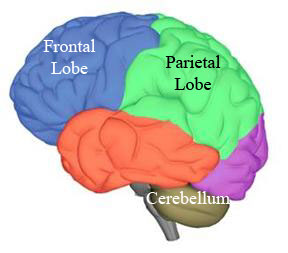 INSTRUCTIONS FOR USE:
INSTRUCTIONS FOR USE:
This OPK flag is used to produce optokinetic nystagmus (OKN), a physiologic jerk in a patient’s eyes. This is elicited when the patient attempts to fixate on moving, alternating, contrasting squares that are moved in the field of vision.
Do not run OPK without having an idea of what you are looking for, as it can be very fatiguing to the brain. For practical purposes, manual OPK tape testing is a useful tool to evaluate hemisphericity, in a general way, especially the fatigability of that specific hemisphere.
To look specifically at Parietal, Frontal and Cerebellar functions, specific pursuit and saccade testing is more specific.
The Optokinetic Reflex can be tested by passing an optokinetic tape in front of the patient’s eyes, first in one direction and then in the other, and observing the motion of the eyes as the tape is passed. The motion of the eyes should be observed keeping in mind the latency and velocity of the response, the amplitude of the response, smoothness of movement of the response, the fatigability of the response, and the direction of the response, all of which should be recorded.
Saccadic eye movements, also referred to as saccades, are rapid movements that move the eye from one object to the next. The saccadic reflexes can be tested by holding an optokinetic tape about 14 inches from the eyes, and moving the tape slowly and steadily first in one direction and then the other direction. Observation of the amplitude, frequency, direction, and smoothness of the saccades generated can give a clue as to the area of the neuraxis that is dysfunctional.
It is useful to say to the person being tested: “watch this.” If the patient doesn’t exhibit an OPK reflex, try saying: “watch the red squares.” If no OPK reflex is elicited, try saying: “watch each red square.”

Stimulus to Patient’s Left Causes:
- Left Parietal Activation (Leftward Pursuit)
- Left Frontal Lobe Activation (Rightward Saccade)
- Right Vestibulocerebellar Activation (Leftward Pursuit and Stops Saccade)
Now that these mechanisms are understood you can understand OPK testing. We know that when the tape moves from the patient’s right to the left in a horizontal fashion, the left occipital lobe sees it, the left parietal lobe pursues it and then the left frontal lobe refixates to the next target to the right and we know the right cerebellum primarily stops the refixation or terminates the refixation back to the left.
Now that you understand the particular eye movements and various activations you can look at ocular movement and determine pathology or breakdown and pinpoint or triangulate a lesion very nicely with this single test.
As always, a single testing modality does not confirm a diagnosis. If you find a hemisphericity with OPK testing, confirm it with other testing procedures.

